Arizona Wild Flowers
Pictures, Photos, Images
Descriptions, Information, Reviews.
Field Bindweed, Convolvulus arvensis.
We Are Proud Of Our SafeSurf Rating!
Click On Any Of The Following Links By Amazon.Com
For Books, & Videos About Wildflowers Of Arizona & The Southwest USA. No Obligation!
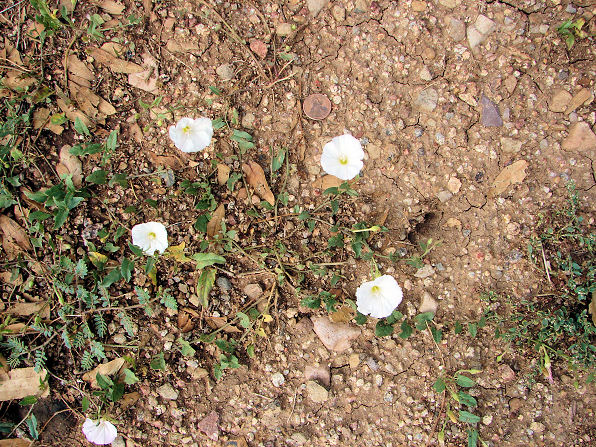 |
| Field Bindweed, Convolvulus arvensis. Photo Taken August 28, 2008. Yarnell, Arizona. |
|---|
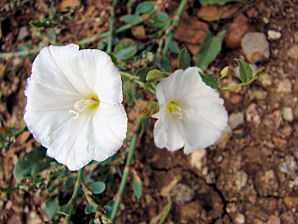 | 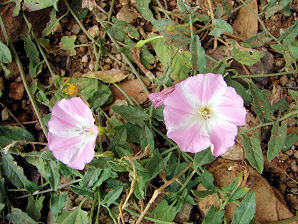 |
| Field Bindweed Flower. | Convolvulus arvensis Flower. |
|---|---|
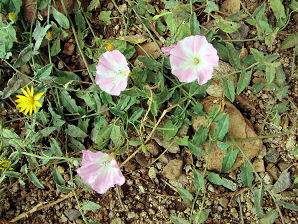 | 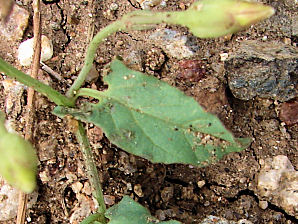 |
| Field Bindweed Flowers. | Field Bindweed Leaf. |
Field Bindweed.
We wish to thank Wikipedia, the free encyclopedia for some of the information on this page. We share images and information with Wikipedia. Vine Forb/herb. Dicot. Perennial. On the Arizona Department Of Agriculture list of list of noxious weeds that Arizona wants to keep out. Field Bindweed, Convolvulus arvensis, is a Eurasian native plant that has thoroughly naturalized itself in almost all of North America. It reproduces both from seed and creeping roots. Its seeds can remain viable in soil for 50 or more years. Field bindweed is agriculture's twelfth most serious weed species. It can be found in small forms of twisted stems or it can have twisted stems that may be 6 feet long, forming dense mats or be found climbing upon other vegetation. Bindweed is a common weed and a problem for many farmers. The weed damags crops by wrapping itself around plants. Growing all over the world, it is sometimes called "the cancer of weeds.� On the good side the plant may have some medicinal purposes. A resin is made from the root which has the following medicinal properties: it promotes the discharge of bile from the system, it increase the secretion and discharge of urine, it has the effect of loosening or opening the intestines, hence stimulating evacuation of faeces and so relieving one from constipation. A proteoglycan mixture (PGM) found in bindweed has been tested to be 100 times more effective at preventing new blood vessel growth than shark cartilage by weight. This testing was done in chicken egg chorioallantoic membranes and was effective in a dose-dependent manner. So what does all that mean? Well, it could be helpfull in the shrinkage of tumors and the assistance in preventing macular degeneration. No testing on humans has been done yet and we would not recommend the use of Bindweed. The plant has a prostrate or underground plant stem, forming shoots above and roots below ground. It serves as a reproductive structure and sometimes they have thickened areas that store starch. The plant is not erect and its trailing stem can extend to a length of several feet. This perennial is a common plant of waste ground, where it either twines around other plants, or sprawls and lies over bare earth. Its loose and unfirm stems are more or less hairless, twining round and give rise to stalked leaves. The leaves are generally arrow shaped up to 40mm long and alternatively arranged along one side of the stem. The flowers have a white color with radial stripes of pink (often star shaped) and a yellowish center from which the 5 stamen and central pistil with 2-parted stigma comes out The ovary is located above the flower parts (the calyx, corolla, and androecium). In other words, the flower parts are attached below the ovary. Its fruit a is rather spherical dehsicent capsule ( A dry round-shaped fruit which splits up open when the seeds are ripe ). It is green which turns yellow/baige on drying out. It holds a maximum of 4 dark brown seeds, which are spherical to oval (lemon shape) with one or two depressions. The seeds are 5 to 6mm in size. Usually only 2 or 3 seeds are found. No obvious method of dispersion, but they are either carried by animals or more probably they just drop off of the plant. They can live in the soil for up to 50 years before germinating.
Quick Notes:
Height: Usually in very low patches or it can reach a height up to about 8 inches.
Flowers: From 1/2 " - 1" wide. They are are usually white to pink, 1 inch wide, and funnel shaped.
Flowering Time: June to September.
Leaves: Arrow-shaped. About 1/4 inch to 2 1/2 inches long and alternatively arranged along one side of the stem.
Found: Native throughout the U.S. except for the extreme Southeast, and southernmost Texas, New Mexico, and Arizona. Found in the Arizona counties of: Yavapai, Coconino, Navajo, and Apache.
Hardiness:
Soil pH requirements:
Sun Exposure:
Elevation: 3,500 - 8,500 Feet.
Habitat: On cultivated, waste and fallow land, roadsides, scrub and, occasionally, on sand-dunes. It also can be found in perennial fields and on cultivated land.
Miscellaneous: Flowering Photos Taken August 28, 2008. Yarnell, Arizona. Herbicides can control this weed.
|
We Are Proud Of Our SafeSurf Rating!
Click On Any Of The Following Links By Amazon.Com
For Books, & Videos About Wildflowers Of Arizona & The Southwest USA. No Obligation!
| © 1966 - Present, Audrey, Eve, & George DeLange |
